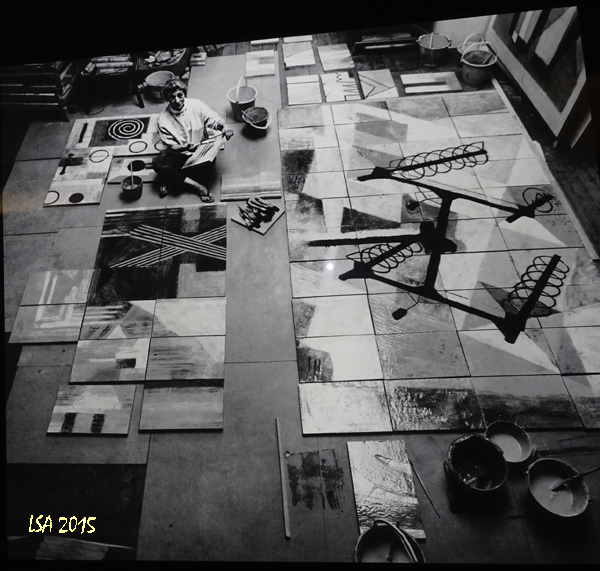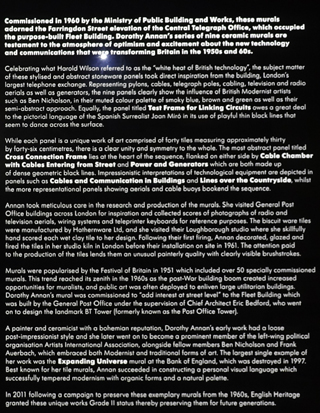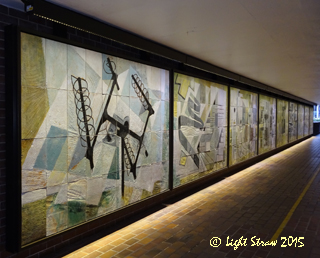 |
In 1960 the Ministry of Works commissioned a series of nine themed telecommunication murals to adorn the newly completed Fleet Building. The murals were researched, designed and crafted by Miss Dorothy Annan. |
Circa 2006 BT's Fleet Building was vacated after being sold to Goldman Sachs for redevelopment.
In September 2012 planning permission was granted for Goldman Sachs to remove the Grade II listed murals.
It was reported by the 'Culture Heritage and Libraries Streets and Walkways Sub Committee'...
"It is proposed that the panels will transfer to the City Corporation ownership on completion of the relocation works and that a dowry of £100,000 provided by Goldman Sachs, be set aside in a ring fenced fund to provide for future maintenance and repair. Analysis of the likely costs associated with repair and maintenance has shown that the sum should be sufficient."
By January 2013, the City of London Corporation had agreed to take ownership of the murals. Site owners Goldman Sachs arranged for the murals to be removed, rennovated and re-sited at the Barbican Centre. Allford Hall Monaghan Morris (AHMM) carried out the restoration and installation in 2014.
AHMM writes... "The new setting required careful orchestration; the accessibility of place, the quality of lighting, the character of frame and the process of installtion are balanced to safeguard the mural's unique charms and respect the Barbican's listed fabric while allowing for the possibility of future relocation."
Fleet Building was demolished early in 2015 and the site of the original commission is being developed.
| Dorothy Annan | |
 |
Text from panel... |
"While each panel is a unique work of art comprised of forty tiles measuring approximately thirty by forty-six centimetres, there is a clear unity and symmetry to the whole. The most abstract panel titled Cross Connection Frame lies at the heart of the sequence, flanked on either side by Cable Chamber with Cables Entering from Street and Power and Generators which are both made up of dense geometric black lines. Impressionistic interpretations of technological equipment are depicted in panels such as Cables and Communication in Buildings and Lines over the Countryside, whilst the more representational panels showing aerials and cable buoys bookend the sequence."
"Annan took meticulous care in the research and production of the murals. She visited General Post Office buildings across London for inspiration and collected scores of photographs of radio and television aerials, wiring systems and teleprinter keyboards for reference purposes. The biscuit ware tiles were manufactured by Hathernware Ltd, and she visited their Loughborough studio where she skilfully hand scored each wet clay tile to her design. Following their first firing, Annan decorated, glazed and fired the tiles in her studio kiln in London before their installation on site in 1961. The attention paid to the production of the tiles lends them an unusual painterly quality with clearly visible brushstrokes."
"Murals were popularised by the festival of Britain in 1951 which included over 50 specially commissioned murals. This trend reached its zenith in the 1960s as the post-War building boom created increased opportunities for muralists, and public art was often deployed to enliven large utilitarian buildings. Dorothy Annan’s mural was commissioned by the General Post Office under the supervision of Chief Architect Eric Bedford, who went on to design the landmark BT Tower (formerly known as the Post Office Tower)."
"A painter and ceramicist with a bohemian reputation, Dorothy Annan’s early work had a loose post-impressionist style and she later went on to become a prominent member of the left-wing political organisation Artists International Association, alongside fellow members Ben Nicholson and Frank Auerbach, which embraced both Modernist and traditional forms of art. The largest single example of her work was the Expanding Universe mural at the Bank of England, which was destroyed in 1997. Best known for her tile murals, Annan succeeded in constructing a personal visual language which successfully tempered modernism with organic forms and a natural palette."
"In 2011 following a campaign to preserve these exemplary murals from the 1960s, English Heritage granted these unique works Grade II status thereby preserving them for future generations."
END
At Speed House
I photographed the murals in July 2015 and they have been cleaned and restored to highlight the vibrant colours and textures which portrayed the optimism of a bygone age in telecommunications and public art.
The Murals (2015)
All logos and trade marks are the property of their respective owners and are used on the Light Straw site(s) for review only. Students and researchers are recommended to make their own independent enquiries as to the accuracy of the information contained therein.
